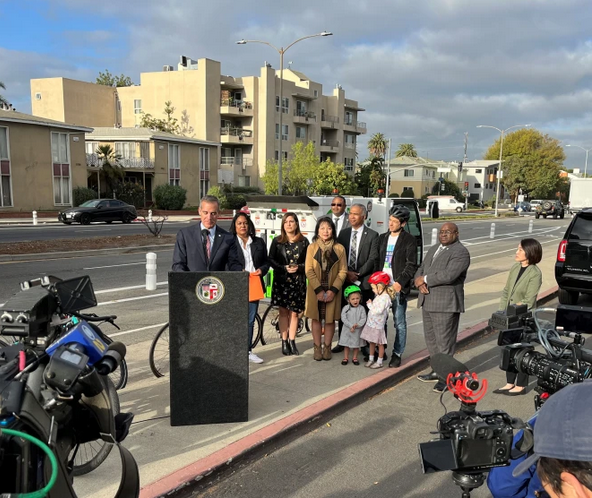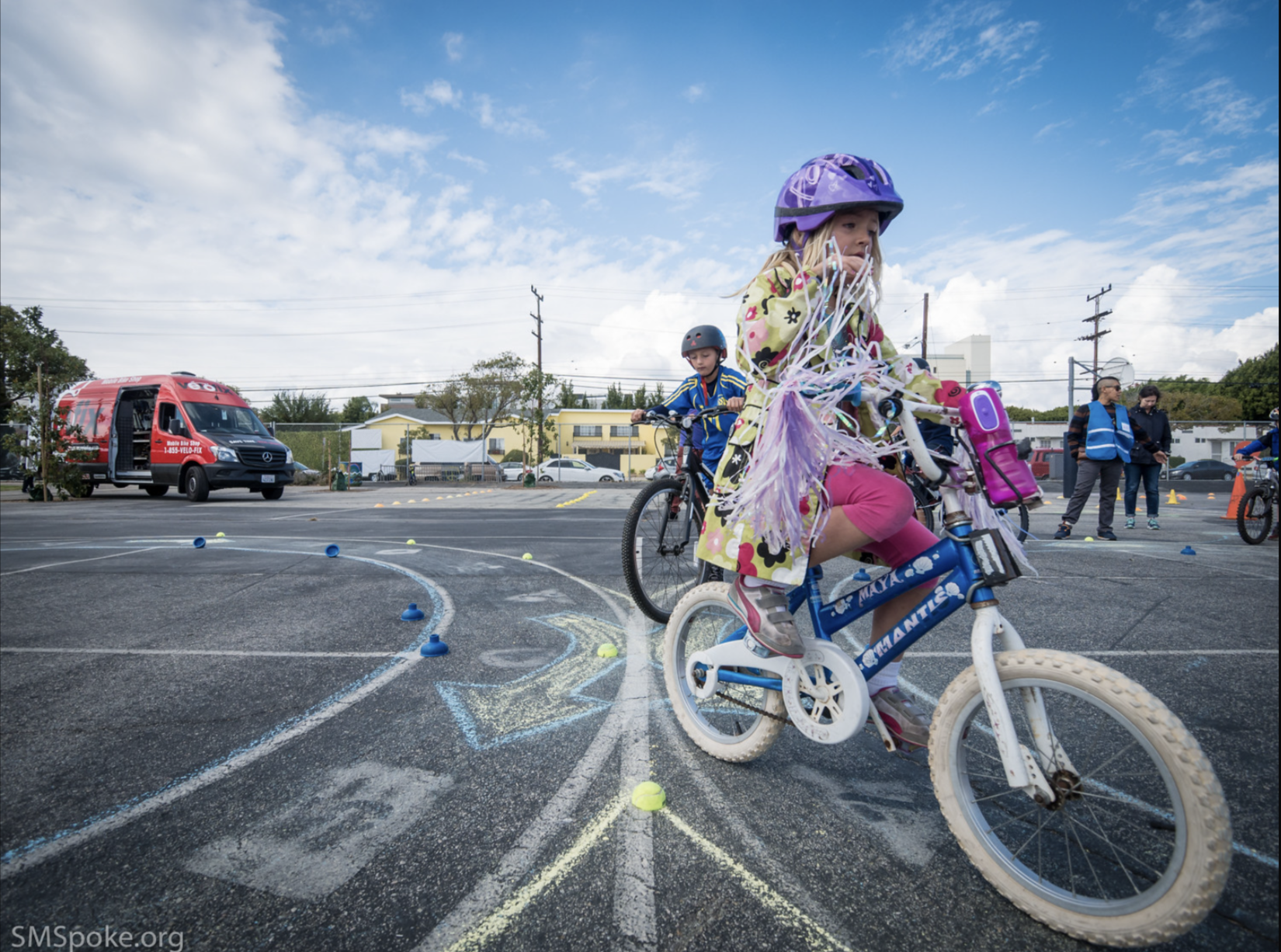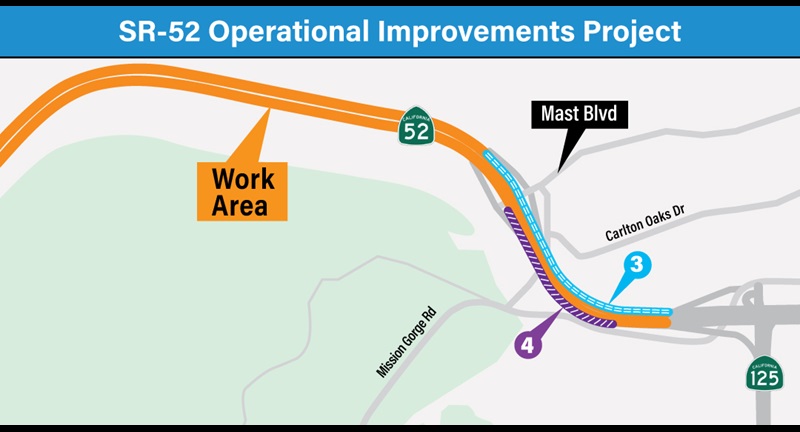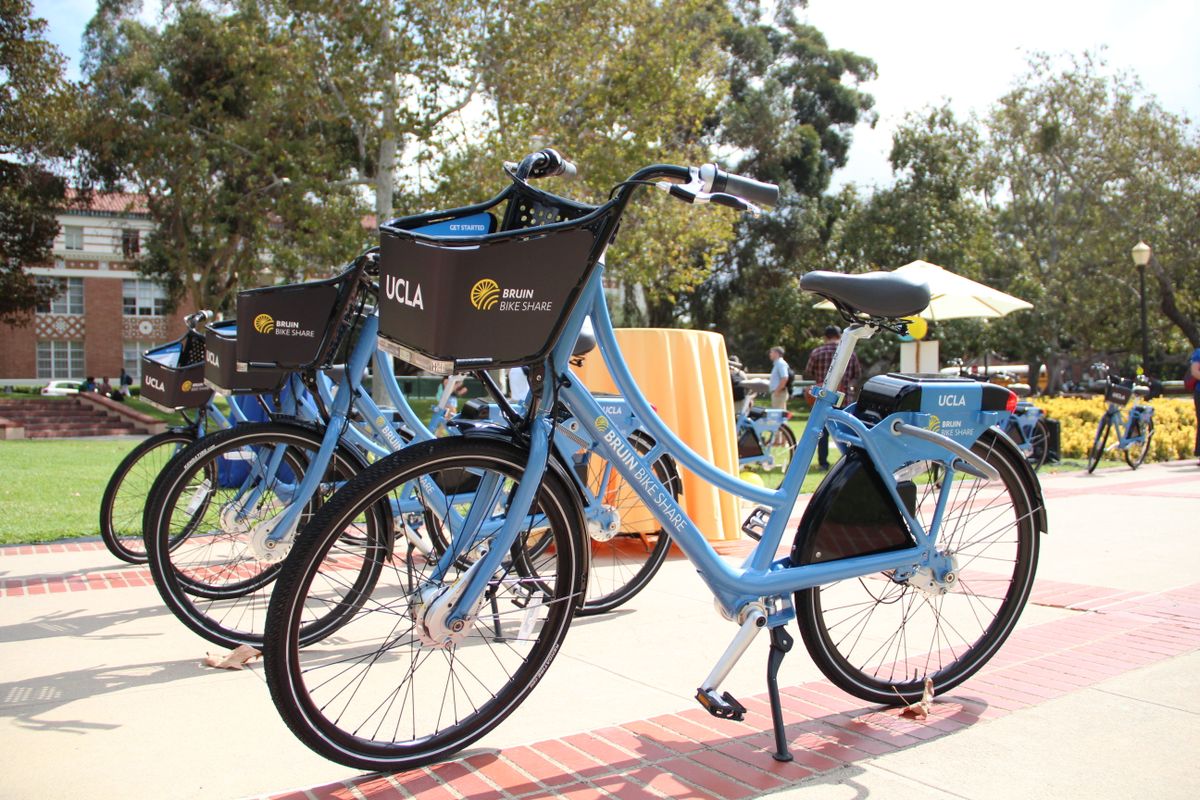This morning, at the new San Vicente protected bike lanes, Mayor Eric Garcetti announced the city's new BLAST Initiative: Bike Lane Acceleration and Safety Team. The mayor touted BLAST as implementing 24 bikeway projects by fiscal year end next July, long after the mayor leaves office in December.
A city statement describes BLAST as a new effort to coordinate the operations of the Bureau of Street Services (StreetsLA) with the Transportation Department (LADOT) to implement "projects like bike lanes." Generally, StreetsLA resurfaces streets and LADOT plans and installs striping on the newly resurfaced streets. Though there has been some collaboration between repaving and bikeway implementation (SBLA noted this in 2021 and 2020), the street surfacing and street design processes have operated more or less independently. Now StreetsLA has essentially set aside some of their annual repaving capacity specifically to support LADOT projects. The city claims that this means it "can deliver large street segments of bike improvements similar to San Vicente rather than just smaller, less-connected bike lane improvements."
Some of the impetus for BLAST comes from a somewhat misguided push for the city to avoid liability. In 2016-2017, the city settled a handful of bike crash lawsuits, some resulting from unsafe pavement conditions. Several councilmembers and local media picked up a narrative that the solution to the liability issue would be for the city to better maintain streets with bike lanes, even though only one of the seven crashes took place on a street with a bike lane. Five of the crashes were blamed on faulty pavement; four of those five took place on streets with no bike lane. Councilmembers proposed removing bike lanes. (Two lawsuits resulted from drivers crashing into cyclists. No councilmembers called for calming traffic or restricting drivers in any way.) Ultimately, the council directed city departments to step up bikeway pavement maintenance and to not add new bike lanes where pavement conditions were poor.
The new policy led to LADOT bikeway projects having to wait for StreetsLA to either certify that pavement condition is good or to wait for StreetsLA to repave. Per the city's statement, "Street segments identified by StreetsLA to improve and maintain the City’s pavement condition do not always align with the length and locations of street segments identified by LADOT for making strategic improvements to the bicycle network. Asking LADOT to react to StreetsLA’s work plan, or vice-versa, results in poor outcomes for both departments." Now, under BLAST, LADOT will "choose a select number of road miles to be resurfaced every year to strategically build out the bike network at a faster pace." BLAST repaving is separate from the broader citywide StreetsLA Pavement Preservation Program (PPP) schedule.
StreetsLA and LADOT plan to install 24 BLAST projects this fiscal year. Mayor Garcetti described the new bikeways as "precise surgical" improvements to "close gaps" in the bike network.
The city provided the below list of streets and locations. Streetsblog has reviewed them and, based on street width and configuration, made a guess (speculation in italics) as to the type of facility being implemented.
- Avenue 60 - Monterey Road to Collins Avenue/South Pasadena city limit. One-way uphill bike lane with downhill sharrows (that's what SBLA recommended there).
- Avenue 64 - Meridian Avenue to Church Street/Pasadena city limit. Bike lanes.
- Avenue 19 - 110 Freeway to San Fernando Road. Protected bike lanes. In 2019, LADOT had announced this facility would be installed by 2020, but was apparently blocked by City Councilmember Gil Cedillo.
- Central Avenue - Century Avenue to Imperial Boulevard. This part of Central already has bike lanes.
- Telfair Avenue - Pierce Street to Branford Street. Bike route. This is part of mini-traffic circle project at Telfair and Montague Street.
- Montague Street - San Fernando Road to Laurel Canyon Boulevard. Bike route. See Telfair above.
- 88th Place - Central Avenue to Avalon Boulevard. Bike route.
- McKinley Avenue - Manchester Boulevard to 89th Street. Bike route.
- Rosewood Avenue - La Brea Avenue to Vista Street. Bike route building on diverter at La Brea.
- Martel Avenue - Melrose Avenue to Beverly Boulevard. Bike route.
- Avenue 50 - Stratford Road to York Boulevard. Bike route.
- Meridian Avenue - Avenue 49 to Avenue 64. Bike route.
- Stratford Road - Avenue 50 to Mount Pleasant Street. Bike route.
- 103rd Street - Success Avenue to Wilmington Avenue. Bike lanes.
- Wilmington Avenue - 112th Street to Imperial Highway. Bike lanes.
- 108th Street - Central Avenue to Wilmington Avenue. Bike route.
- Compton Avenue - 108th Street to Imperial Highway. Bike lanes.
- Willowbrook Avenue - 108th Street to 112th Street. Bike route.
- San Vicente Boulevard - La Brea Avenue to Olympic Boulevard. This project appears done. Though the repaving extended to Olympic Boulevard, the protected bike lanes disappointingly stop several blocks short.
- Windward Circle. Two-way protected bike lanes.
- Grand Boulevard - Windward Circle to Riviera Avenue. Protected bike lanes.
- Glenoaks Boulevard Northbound - Paxton Street to San Fernando city limit (near Brownell Street). This part of Glenoaks already has bike lanes.
- Hazeltine Avenue - Orange Line Bike Path to Oxnard Street. Bike lanes.
- Anaheim Street - Figueroa Street to Alameda Street. Bike lanes.
If Streetsblog's educated guesses are correct, about half of the projects look good - new bike lanes, some protected. Hopefully they will actually be installed soon.
Most of the project list falls well short of "strategic" "large street segments" with "precise surgical" "projects like bike lanes." Several of the projects are short - one, two, or three blocks long. Nearly half (11 of 24) are just bike routes, which, the way LADOT does them, are little better than no bike facility at all.
Today's announcement is good news. City departments are stepping up collaboration better in order to install more bike safety improvements. With pro-bike councilmembers, the quality of the projects could improve.
What doesn't look good is Mayor Garcetti's record.
Today, he touted the importance of active transportation for climate, health, and equity. In the past, he proclaimed his support for a Vision Zero program that would end L.A. traffic fatalities by 2025, though traffic fatalities grew and grew.
Garcetti's record speaks louder than his spin. He presided over a dismal slump in bikeway implementation. He inherited a department that had exceeded 100 bikeway miles annually in the final years under Mayor Antonio Villaraigosa. Under his watch the city's bikeway output plummeted to less than 40 miles, then sputtered around with several years under 20 miles.







